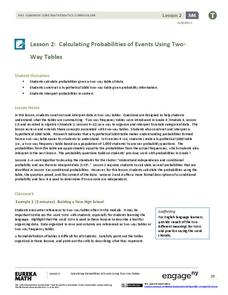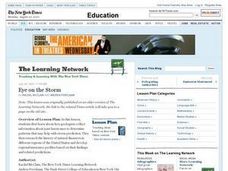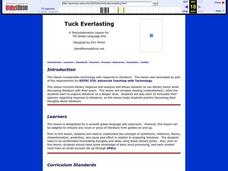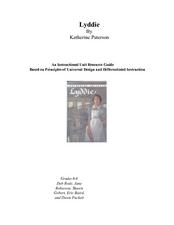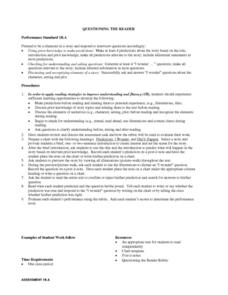EngageNY
Calculating Probabilities of Events Using Two-Way Tables
Tables are useful for more than just eating. Learners use tables to organize data and calculate probabilities and conditional probabilities.
Carolina K-12
Battle Behind the Pumps
After considering the role that gasoline plays in our lives and our dependence on it as a society, learners participate in a reading activity discussing why oil prices are increasing. They will then simulate being members of a committee...
Curated OER
Counting Crows
Students discuss the fable, The Crow and the Pitcher. In this literature lesson, students read the fable and create a crow sock puppet. Students use their puppets to dramatize the fable.
Curated OER
Teddy Bears Everywhere
Learners explore the history of teddy bears. In this comprehension lesson, students bring a bear of their own to compare and contrast with their classmates. Learners read book and discuss the events and draw pictures of the scenes.
Curated OER
The Three Billy Goats Gruff
Learners complete activities with the story The Three Billy Goats Gruff. In this literature lesson, students listen to the story and then participate in shared reading. This lesson offers three extensions which link the story to...
Curated OER
Long Train: 101 Cars on the Track Lesson Plan
Students practice counting, measuring, and predicting. In this early childhood lesson plan, students identify numbers 1-101, rhyming words, and repetitive words using Long Train by Sam Williams. Students build their recall skills by...
Curated OER
Rain
First graders practice oral and silent reading using beginning comprehension and decoding strategies. In this guided reading lesson, 1st graders take a picture walk and make plot predictions prior to reading the book Rain by Robert...
Curated OER
Eye on the Storm
Young scholars discover the way geologists collect information about past hurricanes to determine patterns that may help with storm prediction. They then research the history of natural disasters in different regions of the United States...
Curated OER
Poke and Look Learning Books
Students read Poke and Look Learning Books and complete predicting activities, reading, questioning, and more. In this Poke and Look Learning Books, students do this for 13 different books.
Curated OER
Tuck Everlasting
Seventh graders use literary terms while discussing literature with their peers. They explore literature on a deeper level. Students formulate their opinions regarding response to literature, as this lesson helps students practice...
Curated OER
The Jacket: Journal Templates Teacher's Guide
Explore this story involving prejudice and racism to enhance learners' comprehension skills. The story The Jacket by Andrew Clements involves an African American boy who is falsely accused of stealing someone's jacket. This teacher's...
Curated OER
Lyddie: An Instructional Unit Resource Guide
Katherine Paterson’s young adult novel Lyddie is the foundation of a differentiated instruction unit that not only explores the rise of industrialization and labor but women’s rights issues as well. After learners read the novel, they...
Science 4 Inquiry
Frenemies, Bros and Killers: A Lesson in Symbiosis
Animals and plants develop relationships and rely on each other to survive. Pupils learn more about symbiosis through a video, a hands-on matching activity, and a game. They differentiate and describe each type on a written evaluation.
Curated OER
Weather In Our World
Students examine the concept of weather prediction through a variety of activities: video, discussion, art, storytelling and exploration. They read an aneroid barometer and tell what it measures.
Curated OER
Questioning the Reader
Students consider various reading strategies to improve their understanding and fluency. They review their assessment task and rubric for how their work will be evaluated. They read a story and predict what will happen by recording...
Curated OER
Jubal's Wish
Students discuss the story "Jubal's Wish." In this literature lesson, students take turns making predictions about what will happen next in the story and state their own wish by taking turns as well.
Curated OER
You Can Judge a Book By Its Cover
Fifth graders explore the purpose for reading a piece of literature. In this reading lesson, 5th graders view the cover of a book and then predict the order of details from the book. Students listen to the piece of literature and...
Curated OER
Jellybean Graphs
Second graders predict and graph data based on the color of jelly beans they think are in a handful. In this prediction lesson plan, 2nd graders will predict how many of each color jellybean are in a handful. Then they graph these...
Curated OER
Koala Lou
First graders predict what will happen in different parts of the story Koala Louby Mem Fox. In this predictions lesson plan, 1st graders say and write their predictions.
Curated OER
Scaffolding a Reading/Writing Lesson
Students explore pre-reading activities. Through looking at titles, and observing pictures, students predict what will happen in a story. They listen to a part of the story and then write their own conclusion. Students complete the story...
Curated OER
Pinky and Rex and the Just Right Pet
Students engage in reading comprehension activities for the story "Pinky and Rex and the Just Right Pet". In this reading comprehension lesson, students make prediction drawings before reading the story, create new illustrations for...
Curated OER
WHERE DO BEARS LIVE?
Students practice making predictions about what happen in the story by looking at the pictures and answering questions aloud. Given a blank sheet of paper and writing utensils, students draw a picture of a bear in a den and describe that...
Curated OER
Just Me and My Mom
First graders create predictions for the story, Just Me and My Mom. In this language arts lesson plan, 1st graders read and discuss the story. Additionally, students draw pictures of the events of the story to show who, what, where, and...
Curated OER
Reading Comprehension
Students review the task sheet and information on SQ3R reading strategy. They choose a text for reading then apply SQ3R to the text to preview and ask questions about the content, organizational structure and author's prupose for writing.


